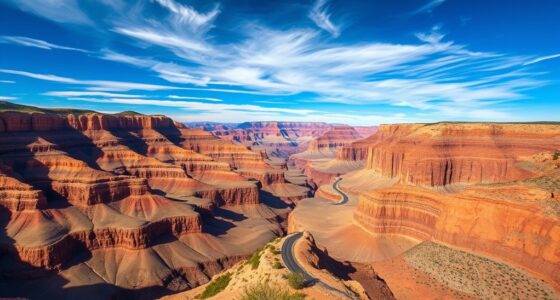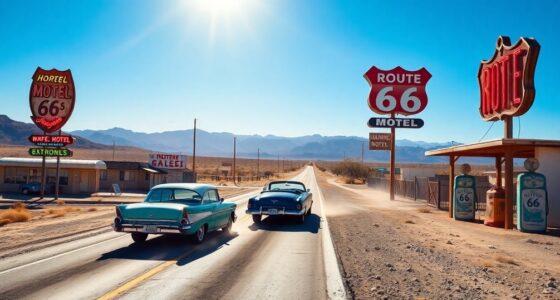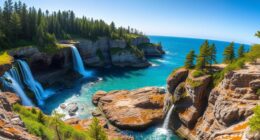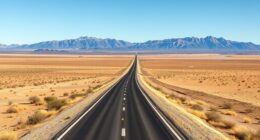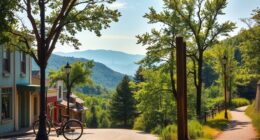Begin a stunning road trip through Southern California’s desert, starting at Joshua Tree with its iconic wildflowers and dramatic rock formations. As you drive toward Death Valley, you’ll encounter vast salt flats, colorful badlands, and resilient desert plants like Joshua trees and prickly pear cacti. At night, the clear desert skies provide perfect conditions for astrophotography of stars and the Milky Way. Keep going to discover the full beauty and diverse landscapes of this extraordinary desert journey.
Key Takeaways
- Explore iconic desert flora like Joshua trees, cacti, and creosote bushes along the scenic route from Joshua Tree to Death Valley.
- Experience stunning landscape transitions from rugged terrain to surreal salt flats and colorful geological formations.
- Enjoy prime astrophotography opportunities with low light pollution, capturing star trails, constellations, and the Milky Way at night.
- Capture vibrant sunset and sunrise scenes, reflecting the desert’s unique textures and landscapes during golden hours.
- Immerse yourself in the resilient desert ecosystem, observing wildlife and natural beauty throughout the journey.

A Southern California desert road trip offers an exhilarating escape into some of the most stunning and diverse landscapes in the region. As you drive from Joshua Tree to Death Valley, you’ll encounter an array of desert flora that embodies the resilience of life thriving in harsh conditions. Joshua Tree National Park, in particular, is a haven for unique desert plants like the iconic Joshua trees, along with prickly pear cacti, cholla, and creosote bushes. These plants, with their sculptural forms, create a surreal landscape that’s perfect for exploration and photography. You’ll find yourself stopping frequently, capturing the intricate details of desert flora against the vast, open skies. The striking contrast between the hardy vegetation and the rugged terrain highlights the beauty of desert adaptation and survival. desert flora plays a vital role in supporting local ecosystems, offering shelter and food for various wildlife species. As the sun begins to set, the desert transforms into a quiet, almost mystical landscape, ideal for night sky photography. Because this region is remote and boasts low light pollution, you get an unobstructed view of the stars. With your camera in hand, you can set up for long exposures that reveal the Milky Way stretching across the darkened sky. The silence of the desert at night adds to the atmosphere, making it easier to connect with the natural beauty around you. Shooting star trails or capturing the constellations becomes a rewarding challenge, especially when the sky is crystal clear. The cool desert air and the shimmering celestial display make for an unforgettable experience, allowing you to appreciate the universe’s grandeur from a quiet, isolated corner of Southern California. Driving further into Death Valley, the landscape shifts to otherworldly vistas, with colorful badlands and salt flats that reflect the night sky’s brilliance. During the day, the stark beauty of these features is impressive, but at night, they become a canvas for astrophotography. The combination of desert flora at dawn or dusk and the expansive night sky offers endless opportunities for capturing contrasting moments of natural beauty. Whether you’re photographing the spindly desert plants silhouetted against a vibrant sunset or the star-studded sky over the salt flats, each scene provides a new perspective on the desert’s raw, untouched charm. This road trip isn’t just about reaching a destination; it’s about immersing yourself in the desert’s unique ecosystems and celestial wonders. From the resilient desert flora to the endless night sky, every mile offers a chance to observe, photograph, and appreciate the natural splendor of Southern California’s desert landscapes.
Frequently Asked Questions
What Is the Best Time of Year to Visit These Deserts?
The best visiting seasons for these deserts are in spring (March to May) and fall (September to November). During these times, the weather considerations are ideal—warm days and cooler nights, avoiding the extreme heat of summer and cold winter. You’ll enjoy comfortable temperatures, clear skies, and fewer crowds, making your trip more enjoyable. Just be sure to check local forecasts to guarantee ideal conditions for your adventure.
Are There Guided Tours Available Along the Route?
Imagine stepping into the vast, sunlit landscape—guided tour options are plentiful along the route, offering expert insights to enhance your experience. You can join organized tours that navigate Joshua Tree’s surreal rock formations or Death Valley’s stark beauty, or opt for self-guided exploration to discover hidden gems at your own pace. Either way, you’ll immerse yourself in the desert’s stunning scenery, making your adventure truly unforgettable.
How Much Water Should I Carry for the Trip?
You should carry at least one gallon of water per person per day for your desert trip. Hydration tips include drinking regularly, even if you don’t feel thirsty, and avoiding alcohol or caffeine. To conserve water, use it wisely—avoid unnecessary splashes and keep hydration bottles sealed when not in use. Always plan for extra water in case of emergencies, and remember that staying hydrated is your top priority in the desert heat.
Are Camping Sites Available in Joshua Tree and Death Valley?
You’ll find plenty of camping sites in Joshua Tree and Death Valley, with over 1,200 campgrounds in Joshua Tree alone. Many offer amenities like restrooms, picnic areas, and fire pits. It’s wise to verify reservation policies ahead of time, especially during peak seasons, as some campgrounds require bookings, while others operate on a first-come, first-served basis. Planning ahead ensures you secure a spot to enjoy the stunning desert landscapes.
What Wildlife Might I Encounter During the Trip?
During your trip, you might encounter fascinating desert creatures like lizards, snakes, and small mammals such as kangaroo rats. Keep an eye out for various bird species, including roadrunners, hawks, and owls. These animals are adapted to the harsh desert environment and often appear at dawn or dusk. Respect their space, stay on designated trails, and enjoy observing the diverse wildlife that makes this desert ecosystem unique.
Conclusion
As you conclude your desert adventure from Joshua Tree to Death Valley, you realize the land’s mystique isn’t just myth. Some say the desert’s extreme conditions create a hypnotic, almost otherworldly aura, fueling stories of spirits and ancient secrets. Whether or not you buy into the lore, one thing’s clear—you’ve experienced a landscape that challenges and inspires, leaving you with a sense of wonder and a new appreciation for nature’s raw, untamed beauty.

